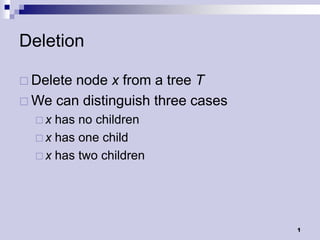
Lec9
- 1. Deletion Deletenode x from a tree T We can distinguish three cases x has no children x has one child x has two children 1
- 2. Deletion Case 1 If x has no children – just remove x 2
- 3. Deletion Case 2 Ifx has exactly one child, then to delete x, simply make p[x] point to that child 3
- 4. Deletion Case 3 Ifx has two children, then to delete it we have to findits successor (or predecessor) y remove y (note that y has at most one child – why?) replace x with y 4
- 5. Delete Pseudocode TreeDelete(T,z) 01 if left[z] NIL or right[z] = NIL 02 then y z 03 else y TreeSuccessor(z) 04 if left[y] NIL 05 then x left[y] 06 else x right[y] 07 if x NIL 08 then p[x] p[y] 09 if p[y] = NIL 10 then root[T] x 11 else if y = left[p[y]] 12 then left[p[y]] x 13 else right[p[y]] x 14 if y z 15 then key[z] key[y] //copy all fileds of y 16 return y 5
- 6. In order traversal of a BST ITW can be thought of as a projection of the BST nodes onto a one dimensional interval 6
- 7. BST Sorting Use TreeInsert and InorderTreeWalk to sort a list of n elements, A TreeSort(A) 01 root[T] NIL 02 for i 1 to n 03 TreeInsert(T,A[i]) 04 InorderTreeWalk(root[T]) 7
- 8. BST Sorting (2) Sort the following numbers 5 10 7 1 3 1 8 Build a binary search tree Call InorderTreeWalk 1 1 3 5 7 8 10 8
- 9. In what order should we insert? We want to sort numbers {1,2,…,n} Total time taken to insert these numbers equals the sum of the level numbers of the nodes. Thus if numbers were inserted in ascending order we would get a tree of height n-1 in which there is one node at each level. So total time for insertion in this case is 1+2+3+…+n-1 = O(n2). 9
- 10. Inserting a random permutation Suppose we take a random permutation of the keys and inserted them in this order. The total time required for insertion is now a random variable. We want to compute the expected value of this r.v. Recall that the expected value of a r.v. is the average value it takes over a large number of trials. 10
- 11. Expected insertion time for a random permutation We will compute the average time taken to insert keys in the order specified by the n! permutations. In other words, for each of the n! permutations we will compute the time taken to insert keys in that order and then compute the average. Let T(n) denote this quantity. 11
- 12. Inserting a random permutation (2) Of the n! permutations, there are (n-1)! permutations in which the first element is i. The tree formed in these instances has i as the root. The left subtree has keys 1..(i-1) and the right subtree has keys (i+1)..n Consider the ordering of keys 1..(i-1) in the (n-1)! permutations. All (i-1)! permutations appear and each occurs (n-1)!/(i-1)! times. 12
- 13. Inserting a random permuation(3) Recall that if we only had keys 1..(i-1) then average time taken to insert them is T(i-1). The average is taken over all permutations of 1..(i-1). hence total time to insert all (i-1)! permutations is (i-1)!T(i-1). 13
- 14. Inserting a random permutation(4) When inserting keys 1..(i-1) into the left subtree, each key has to be compared with the root. This leads to an additional unit cost for each key. So total time to insert all (i-1)! permutations is (i-1)!(T(i-1)+(i-1)). Since each permutation appears (n-1)!/(i-1)! times, total time to insert keys 1..(i-1) is (n-1)!(T(i-1)+(i-1)) 14
- 15. Inserting a random permutation(5) Time to insert keys 1..(i-1) is (n-1)!(T(i-1)+(i-1)) Similarly, time to insert keys (i+1)..n is (n-1)!(T(n-i)+(n-i)) Total time to insert all n keys in permutations where the first key is i is (n-1)! (T(i-1)+T(n-i)+ n-1) Total time to insert all n keys in all n! permutations is (n-1)! i=1n (T(i-1)+T(n-i)+ n-1). 15
- 16. Building the recurrence We are expressing the value of function T() at point n in terms of the value of T() at points 0..n- 1. This is called a recurrence relation. 16
- 17. Solving the recurrence 17
- 18. Solving the recurrence(2) 18
- 19. Summing the harmonic series What is the sum ½+ 1/3 + ¼+…1/n? 1/x 1/2 1/3 1/41/5 1/n 1/6 x 1 2 3 4 5 6 n It is at most the area under the curve f(x)=1/x between limits 1 and n 19
- 20. The expected time for insertion Thus the expected time for inserting a randomly chosen permutation of n keys is O(n log n) 20
- 21. Minimum time to insert n keys The time required to insert n keys is minimum when the resulting tree has the smallest possible height. A binary tree on n nodes has height at least log2 n To insert the n/2 nodes at level log2 n we require at least (n/2)log2 n time. Hence inserting n keys requires (nlog2 n) time. 21
- 22. Summary of Running times To insert n keys into a binary search tree which is initially empty requires O(n2) time in the worst case. O(nlog n) time in the best case. O(nlog n) time in the average case; the average is taken over the n! different orders in which the n keys could be inserted. 22
